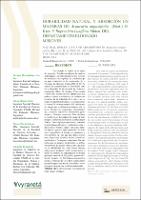Durabilidad natural y absorción en maderas de Araucaria angustifolia (Bert.) O. Ktze. y Ruprechtia Laxiflora Meisn. del departamento Eldorado Misiones
Natural durability and absorption in Araucaria angustifolia (Bert.) O. Ktze woods and Ruprechtia Laxiflora Meisn. in the department of Eldorado Misiones
Date
2021-02-17Author
Godoy, Hernán Maximiliano
Stehr, Alicia Mónica
Suirezs, Teresa María
Bragañolo, Adelaida
Metadata
Show full item recordAbstract
Este trabajo se realizó en el marco del proyecto “Estudio tecnológico de maderas impregnadas y no impregnadas de tres especies de coníferas y tres especies de latifoliadas aptas para la industria de la construcción, de la Provincia de Misiones. Código ISIF: II 21”. Se estudió las características de durabilidad natural y absorción de las maderas de Araucaria angustifolia (Bert.) O. Kuntze, (Pino paraná) y Ruprechtia laxiflora Meisn. (Mamelero). Las probetas fueron seleccionadas de maderas comerciales de las industrias de la zona. Los estudios de durabilidad natural, se realizaron bajo la Norma EN (Norma europea) 113 modificada; los hongos que se utilizaron pertenecen a la especie: Pycnoporus sanguineus, Gloeophyllum sp., Laetiporus sulphureus, Ganoderma applanatum y Pleurotus sajor-caju. Para clasificar la resistencia de las maderas al ataque de tales hongos se utilizó la clasificación establecida por Findlay. Tanto el pino paraná como el marmelero presentaron diferencias significativas ante el ataque de los distintos hongos utilizados, siendo las especies que más daño generaron a la Araucaria angustifolia, el Laetiporus sulphureus y Gloeophyllum sp.; los que más daños generaron a Ruprechtia laxiflora, fueron Ganoderma applanatum y Pycnoporus sanguineus. Por otra parte, para los ensayos de absorción, se utilizaron probetas de iguales dimensiones que para los de durabilidad, las cuales fueron impregnadas con el producto CA-B (copper azole), a través del método de impregnación de Burnett aplicando vacío de -0,50 kg/cm2 y presión de 7 kg/cm2, durante 15 y 120 minutos consecutivamente, y 5 minutos de vacío final, siendo el pino paraná la especie que mejor capacidad de absorción presentó para este producto mencionado. This work was carried out within the framework of the project “Technological study of impregnated and non-impregnated woods of three species of conifers and three species of hardwoods suitable for the construction industry in the Province of Misiones. ISIF code: II 21”. The natural durability and absorption characteristics of Araucaria angustifolia (Bert.) O. Kuntze, (paraná Pine) and Ruprechtia laxiflora Meisn. (marmelero) woods were studied. The specimens for these tests were selected from commercial woods from industries in the area. The natural durability studies were carried out under the modified EN Standard (European Standard) 113; the fungi to be used belong to the species: Pycnoporus sanguineus, Gloeophyllum sp., Laetiporus sulphureus, Ganoderma applanatum and Pleurotus sajor-caju. In turn, the classification established by Findlay was used to classify the resistance of wood to such fungal attack. The Paraná pine, as well as the Marmelero, presented significant differences to the attack of the different fungi used, being Laetiporus sulphureus and Gloeophyllum sp. the species of fungi that caused the most damage to Araucaria angustifolia, For Ruprechtia laxiflora, the fungi that caused the most damage were Ganoderma applanatum and Pycnoporus sanguineus. For the absorption tests, specimens of the same dimensions as those for durability tests were used, which were impregnated with the product CA-B (copper azole), composed of copper and azole, through the impregnation method of Burnett applying vacuum of -0.50 kg / cm2 and pressure of 7 kg / cm2, for 15 and 120 minutes consecutively, and 5 minutes of final vacuum, being the Paraná pine the species with the best absorption capacity for the mentioned product.
Collections
- Revista Yvyraretá [360]
The following license files are associated with this item:



